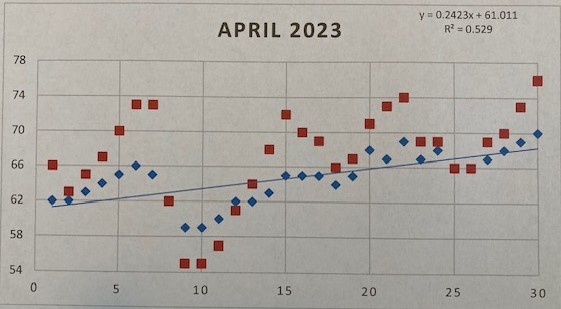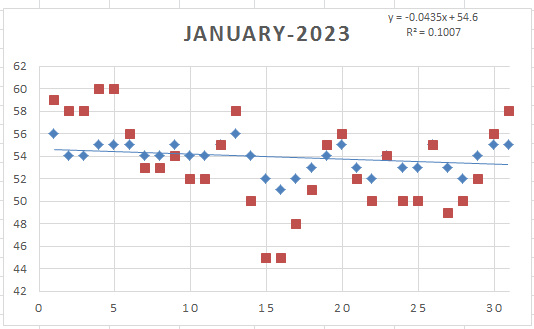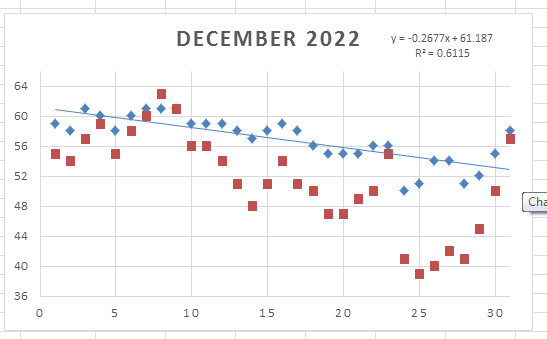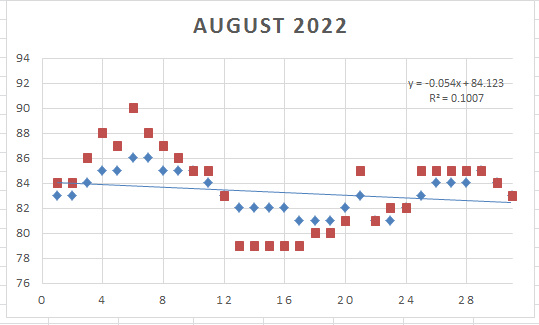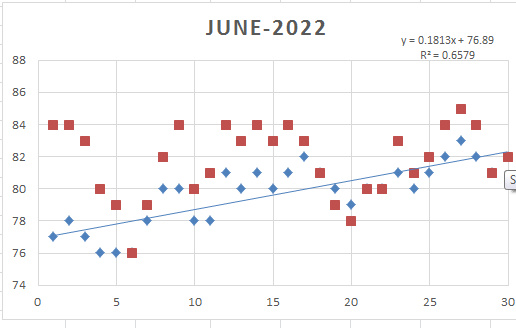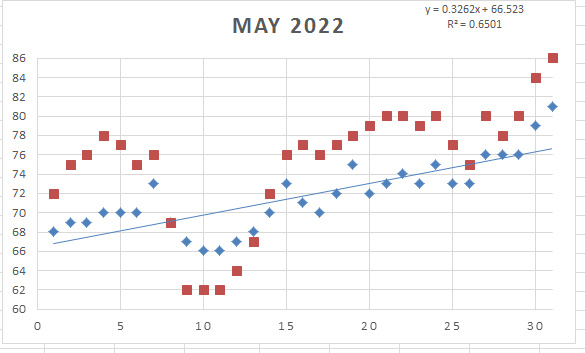Water temps continued to hold above normal like they have much of last year and now well into 2023 but with the erratic weather during April the temps bounced up and down like a ping-pong ball. The surf temps ranged from a low of 59° to a high of 70° with an average of 64.8° +/-2.9° a gain of 0.24°/day (line slope). The sound had a low of 55° and a high of 76°, a 21-degree spread, with an average of 67.3° +/- 5.4°. Surf temps are blue diamonds, sound red squares.
Emerald Isle Water Temperatures for January 2023
Water temps continued to hold above normal like they have much of last year. The surf temps ranged from a high of 56° to a low of 51° with an average of 53.9° +/-1.2°. The sound had a high of 60° and a low of 45° with an average of 53.4° (2-degrees above December) with a varying of 15° over the month and a error of +/- 4.1°. Normally temps start January at 52 and drop to 48 by the end of the month. This January 2023 surf temperatures wiggled around but were essentially flat, with a slope of -0.04, basically zero. Surf temps are blue diamonds, sound red squares.
Emerald Isle Water Temperatures for December 2022
Water temps continue to hold above normal like they have much of the year. The surf temps ranged from a high of 61° to a low of 50° with an average of 56.9°. The sound had a high of 63° and a low of 39° with an average of 51.5° with a large variation of 24° over the month and a variation of +/- 6.5°. It was again another dry month for 2022. Fall fishing was late to nonexistent in the surf this year and there is still plenty of bait (shrimp and mullet) in the backwaters and way up the rivers as the salt lines are way inland. Reports of this are for both Neuse and Pamlico Rivers. Surf temps are blue diamonds, sound red squares.
Water temps continue to hold above normal like they have much of the year starting in the 70s at the beginning of the month and dropping quite a bit but despite that remaining above normal. The surf temps ranged from a high of 72° to a low of 59° with an average of 65.2°, the average was 70.0° +/- 4.2° (4.2° is very a big variation) for the month and had a negative slope of about 0.40. We are usually solidly in the 50s by Thanksgiving for the EI surf. The sound had a high of 74° and a low of 50° with an average of 62.1° with a large variation of 24° over the month and a variation of +/- 6.9°. It was again another dry month for 2022. Fall fishing seems to be late this year and there is still plenty of bait (shrimp and mullet) in the backwaters and way up the rivers as the salt lines are way inland. Surf temps are blue diamonds, sound red squares.
Interesting month with water temps average to slightly below normal. The surf temps ranged from a high of 74 to a low of 67 but from mid-October on, were mostly 68° with only minor changes from 67° to 69° along the way, the average was 70.0° +/- 2.2° (2.2 is very tight) for the month and had a negative slope of about 0.20. The sound held mainly low to mid 60s with an average of 67.1° +/- 2.9° with a high of 72° and a low of 62°. It was another dry month except for Ian late September into October 1st. Fall fishing seems to be late this year and there is still plenty of bait shrimp and mullet) in the backwaters. Surf temps are blue diamonds, sound red squares.
Emerald Isle Water Temperatures for September 2022
Another hot month to start but temps dropping through the month with temps ranging over a 12° drop for the surf and a huge 19° drop for the sound. We also had at least 4 good peak runs of bait mullets during the month along with good runs of bay anchovies. Surf temps for September ranged from a high of 85° to a low of 73° averaging 81.2° +/-3.0. Bogue Sound had a high of 86°, with a low of 67°, averaging 79.3° +/-5.1. Check out the graph with its downward roller coaster swings, blue diamonds are the surf, red squares are the sound temperatures. Surf temperature line slope was a negative 0.3°/day fall in temperature. It’s fall, and early October has reinforced that with chilly north winds and a continued drop in air and water temperatures.
Emerald Isle Water Temperatures for August 2022
Another hot month with temps above average through the month of July and noticeably FLAT with a slightly negative temperature curve. No wonder the surf fishing and pier action is again slow. Surf temps for July were ranged from a high of 86 to a low of 81 averaging 83.2 +/- 1.15, same as July. Bogue Sound was had a high of 90°, which I haven’t seen for decades with a low of 79°, averaging 83.6 +/- 3.1just a little lower than July and essentially the same as the surf. There were scattered scout mullet in the surf but the mullet blow #1 wasn’t until 9/4/22. Check out the graph with its roller coaster swings, blue diamonds are the surf, red squares are the sound temperatures.
Emerald Isle Water Temperatures for July 2022
Another hot month with temps above average through the month of July and noticeably FLAT with very little fluctuation. No wonder the surf fishing and pier action is again slow. Surf temps for July were ranged from a low of 82 to a high of 84 averaging 83.2 +/- 0.8. Bogue Sound was had a low of 80° with a high of 87°, averaging 84.3 +/- 1.4. Check out the graph with its big undulating swings, blue diamonds are the surf, red squares are the sound temperatures.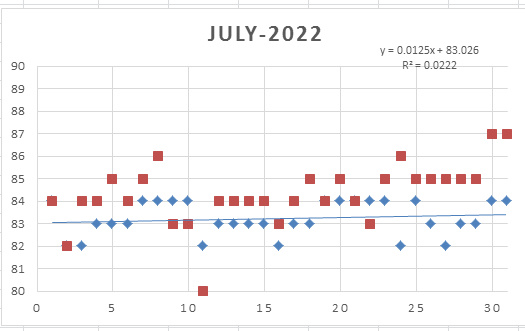
Emerald Isle Water Temperatures for June 2022
Another hot month with temps above average through the month of June. No wonder the surf fishing and pier action is slow. Surf temps for May were ranged from a low of 76 to a high of 84 averaging 79.7 +/- 2.0, 8-degrees above May. Bogue Sound was had a low of 76° with a high of 85°, averaging 81.2 +/- 2.2, about 7-degrees above May. Check out the graph with its big undulating swings, blue diamonds are the surf, red squares are the sound temperatures.
Emerald Isle Water Temperatures for May 2022
What a wild month with big swings ending with surf temp at 81…mid July territory. Surf temps for May were ranged from a low of 66 to a high of 81 averaging 71.7 +/-3.7, over 7-degrees above April. Bogue Sound was had a low of 62° with a high of 86°, averaging 75.1 +/- 6.2, 9-degrees above April. Check out the graph with its big undulating swings, not unlike April blue diamonds are the surf, red squares are the sound temperatures.

